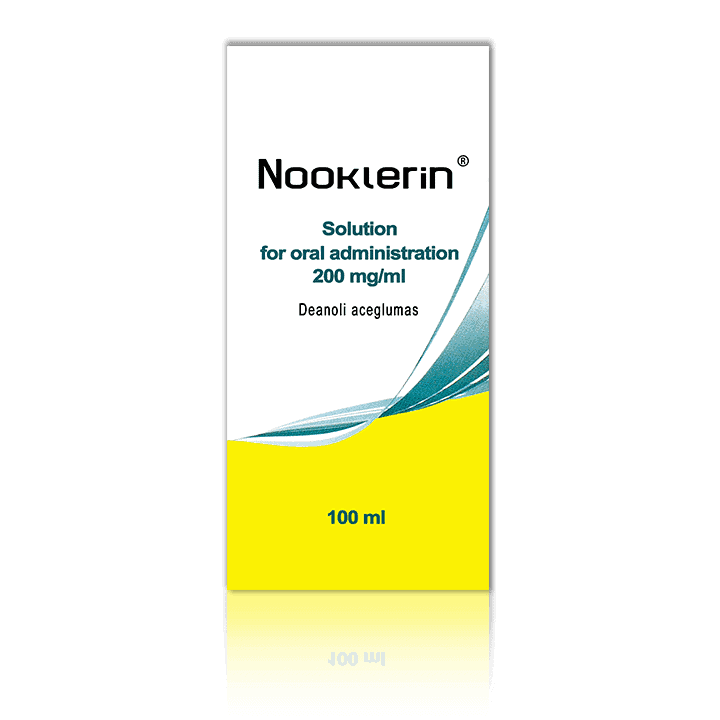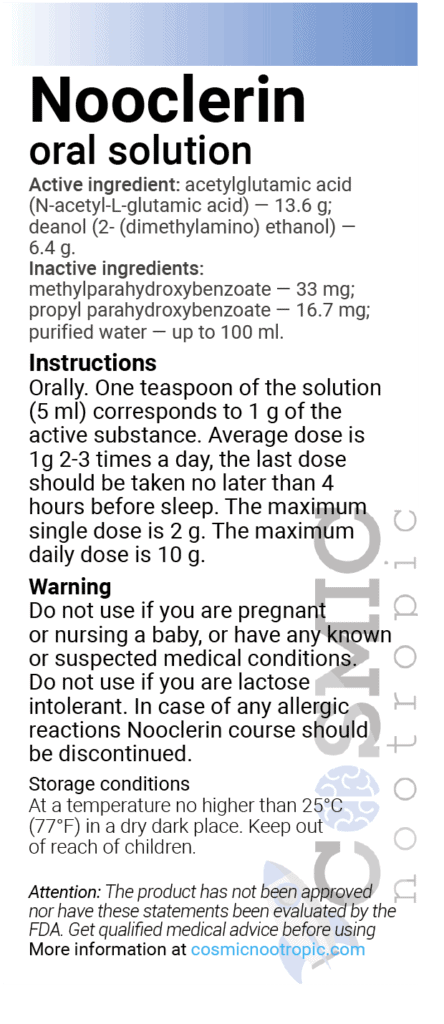Card payments are temporarily suspended for technical reasons! Please consider paying with cryptocurrencies with 15% off.
Card payments are temporarily suspended for technical reasons! Please consider paying with cryptocurrencies with 15% off.
days left

AUTHENTIC PRODUCTS
Only original pharmaceutical products that passed 3 stages of clinical trials.

GMP QUALITY
Our products are produced on GMP or state licensed factories.

10% CRYPTO DISCOUNT
10% discount for paying in BTC or other cryptocurrency.

PAYMENT BY CARD
Convenient Payment by Visa or MasterCard.

GUARANTEED DELIVERY
Guaranteed delivery times and clear Reshipment & Refund Rules.

PROMPT SHIPPING
Different shipping methods and same or next day shipping.
DMAE (Deanol Aceglumate, Nooclerin ®)
1 Reviews
Buy DMAE Online!
Nooclerin® (also known as DMAE or Deanol aceglumate) is one of the oldest known nootropic with cognitive-enhancing and anti-aging properties. In medical practice, it is used to treat chronic fatigue, depression, ADHD, and tardive dyskinesia.
| Other names | Deanol Aceglumate / Dimethylethanolamine / Nooclerin / DMEA |
| Form: | 100ml solution of 200mg/ml |
| Form description: | Solution for oral administration of pinkish or yellowish color with a characteristic odor. |
| Active ingredient: | Deanol aceglumate – 20 g, including N-acetyl-L-glutamic acid – 13.6 g, deanol (2-(dimethylamino)ethanol) – 6.4 g |
| Excipients: | Xylitol (xylitol), methyl parahydroxybenzoate, propyl parahydroxybenzoate, purified water. |
| СAS Number: | 108-01-0 |
| ATC code: | N06BX04 |
| Pharmacological action: | Nootropic |
| Shelf life: | 3 years. Do not use it beyond the expiration date printed on the package. |
| Storage conditions: | Store in a dry dark place at temperatures no higher than 25°C (77°F). Keep out of reach of children. |
| Terms of release: | Over-the-counter |
| Manufacturer: | PIQ-Pharma, Russia |
What is DMAE (Nooclerin)?
Nooclerin (Deanol aceglumate or DMAE) is one of the oldest nootropic drugs. It is also known as DMAE, a widely used cognitive-enhancing and anti-aging supplement.
Deanol has a history of medicinal use since the 1950s; back then, it was marketed in North America under the trade name “Deaner” as a treatment for learning disabilities, ADHD for children, chronic fatigue, and depression.
Later, the drug was discontinued by the FDA; however, it is still being used in Russian medical practice.
What is the Mechanism of Action of DMAE (Nooclerin)?
The exact mechanism of action is still unclear. Initially, it was proposed that DMAE, as a choline precursor, is able to increase brain acetylcholine levels, thus producing a cholinergic effect. However, the results of research on the drug’s pharmacology are controversial and put into question the fact that Deanol’s primary mechanism of action is cholinergic.
More recent studies suggest that DMAE acts as a potent free radical scavenger and antioxidant, which may be responsible for its anti-aging and nootropic effects.
What is DMAE Used For?
Nooclerin (DMAE) is often prescribed to treat the following diseases:
- Asthenia (chronic fatigue);
- Depression;
- Recovery from traumatic brain injuries;
- Alcohol abstinence syndrome;
- Decreased mental capacity in children above 10 years of age;
- Neurasthenia and organic brain syndrome.
According to numerous clinical trials, DMAE has moderate efficacy in the treatment of tardive dyskinesia.
Nooclerin (DMAE) might be used as a safer alternative to Adderall, because Nooclerin has fewer side effects compared to amphetamine derivatives that are often used in ADHD treatment.
Where Can I Order DMAE Online?
You can buy DMAE online at different vendors. CosmicNootropic offers DMAE (Nooclerin) in the form of 100mlx200mg/ml solution. We offer worldwide shipping! Always be sure to do your research before purchasing any nootropic supplement to ensure you are getting a quality product.
You can order DMAE and get it delivered to the USA, Europe, the UK, Asia, and many other regions and countries via CosmicNootropic.
Legal Disclaimer
This product has not been approved by the US FDA. All statements on this page are for informational purposes only and have not been evaluated by the US FDA.
This product is not intended to diagnose, treat, cure, or prevent any disease. See more
What is DMAE Dosage, How to Use It?
Nooclerin is administered orally.
One measuring spoon of solution (5 ml) contains 1 gram of the active ingredient. The recommended dosage for adults is one spoon 2-3 times a day, not later than 4 hours prior to bedtime. The maximum single dose is 2 grams (two measuring spoons). If necessary, the maximum daily dosage can be increased to 10 grams.
The recommended dosage for children of 10–12 years of age is 0.5–1 spoon a day. The recommended dosage for children older than 12 years old is 1-2 spoons a day.
The length of the treatment course is 1.5–2 months. The courses can be taken 2-3 times over a one-year period.
What are the Side Effects of DMAE?
Possible side effects include:
- Allergic reactions;
- Headaches;
- Insomnia;
- Constipation;
- Weight loss;
- Itching.
Contraindications
- Hypersensitivity;
- Infectious diseases of the central nervous system;
- Feverish and psychotic conditions;
- Blood disorders;
- Liver and/or kidney disorders;
- Pregnancy and lactation;
- Patient’s age under 10 years old.
Drug interaction
Deanol may potentiate the effect of psychostimulants.
OFFICIAL INSTRUCTION
- A Cherkin, M Exkardt (1977) Effects of dimethylaminoethanol upon life-span and behavior of aged Japanese quail https://www.ncbi.nlm.nih.gov/pubmed/830732
- R Jope, D Jenden (1979) Dimethylaminoethanol (deanol) metabolism in rat brain and its effect on acetylcholine synthesis https://www.ncbi.nlm.nih.gov/pubmed/512912
- W Sergio (1988) Use of DMAE (2-dimethylaminoethanol) in the induction of lucid dreams https://www.ncbi.nlm.nih.gov/pubmed/3173167
- J Lohr, M Acara (1990) Effect of dimethylaminoethanol, an inhibitor of betaine production, on the disposition of choline in the rat kidney https://www.ncbi.nlm.nih.gov/pubmed/2405150
- Uhoda et al (2002) Split face study on the cutaneous tensile effect of 2-dimethylaminoethanol (deanol) gel https://www.ncbi.nlm.nih.gov/pubmed/12236885
- Dimpfel et al (2003) Efficacy of dimethylaminoethanol (DMAE) containing vitamin-mineral drug combination on EEG patterns in the presence of different emotional states https://www.ncbi.nlm.nih.gov/pubmed/12844472
- R Grossman (2005) The Role of Dimethylaminoethanol in Cosmetic Dermatology https://www.researchgate.net/publication/8056003
- Gragnani et al (2007) Dimethylaminoethanol affects the viability of human cultured fibroblasts https://www.ncbi.nlm.nih.gov/pubmed/17940822
- Morissette et al (2007) The antiwrinkle effect of topical concentrated 2-dimethylaminoethanol involves a vacuolar cytopathology https://www.ncbi.nlm.nih.gov/pubmed/17300230
- Blin et al (2009) Effects of dimethylaminoethanol pyroglutamate (DMAE p-Glu) against memory deficits induced by scopolamine: evidence from preclinical and clinical studies https://www.ncbi.nlm.nih.gov/pubmed/19756528
- K Tadini, P Campos (2009) In vivo skin effects of a dimethylaminoethanol (DMAE) based formulation https://www.ncbi.nlm.nih.gov/pubmed/20095140
- Clares et al (2010) Structural characterization and stability of dimethylaminoethanol and dimethylaminoethanol bitartrate for possible use in cosmetic firming https://www.ncbi.nlm.nih.gov/pubmed/20716435
- Malanga et al (2012) New insights on dimethylaminoethanol (DMAE) features as a free radical scavenger https://www.ncbi.nlm.nih.gov/pubmed/22300295
- Noskov et al (2013) Deanol aceglumate (nooclerin): Clinical/pharmacological aspects and relevance in clinical practice https://www.researchgate.net/publication/259766286
- Liu et al (2014) Effects of Dimethylaminoethanol and Compound Amino Acid on D-Galactose Induced Skin Aging Model of Rat https://www.ncbi.nlm.nih.gov/pmc/articles/PMC4123624/
- Smulevich et al (2017) Nooklerin (deanoli aceglumas) in the treatment of astenic and cognitive disorders in patients with borderline psychopatological conditions https://www.ncbi.nlm.nih.gov/pubmed/29053118
- Agibalova et al (2018) Alcohol withdrawal syndrome dynamics during treatment with nooclerin (deanoli aceglumas) https://www.ncbi.nlm.nih.gov/pubmed/29658504
- Shipilova et al (2019) [The influence of nooclerin on the structure of sleep disturbances in children with tension headaches] https://pubmed.ncbi.nlm.nih.gov/31851171/
- M Malík, P Tlustoš (2022) Nootropics as Cognitive Enhancers: Types, Dosage and Side Effects of Smart Drugs https://www.mdpi.com/2072-6643/14/16/3367
1
Based on 1 Reviews
(0)
(0)
(0)
(0)
(1)
03/09/2023
Fazle R.
Verified Buyer
US
Another scam company
I ordered through everything they said and they scammed me for my money. Guys don’t buy supplements online.
03/10/2023
Dear Fazle, I see that your parcel was not delivered because the receiver was unavailable (as stated in the tracking information). This may have been due to an incorrect address. Unfortunately, you didn't contact us and we weren't able to help. 😓 Please email us if you have any difficulties or questions about your order. We are always ready to help.🙏
Thank you!
You will now receive regular updates from us!
Your coupon

